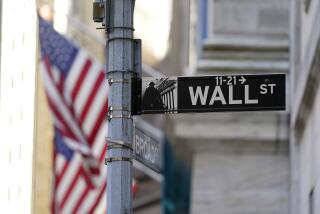S&P downgrades U.S. credit rating
Reporting from Washington — Standard & Poor’s downgraded the U.S. government’s credit rating Friday for the first time in history, saying the recent plan worked out to raise the federal debt ceiling “falls short” of what’s needed to stabilize the nation’s longer-term finances.
The credit rating agency also said the partisan stalemate that put the U.S. on the brink of default this week did not bode well for efforts to reduce the nation’s soaring debt.
“The political brinkmanship of recent months highlights what we see as America’s governance and policymaking becoming less stable, less effective and less predictable than what we previously believed,” said S&P, one of three leading credit rating agencies.
“The statutory debt ceiling and the threat of default have become political bargaining chips in the debate over fiscal policy.”
U.S. debt now will carry a rating of AA-plus instead of the coveted AAA, dropping it into the same general category as countries such as Japan, China, Spain, Taiwan and Slovenia.
The downgrade could increase U.S. borrowing costs because its bonds could be considered more risky. The higher interest rates the U.S. Treasury might have to charge for its bonds could spill over into other areas, such as mortgages.
But the impact of S&P’s move could be muted because Treasury bonds are still considered a safe haven, particularly in stressful financial conditions. In addition, the other two leading credit rating agencies — Moody’s Investors Service and Fitch Ratings — decided this week to keep their AAA rating for U.S. debt for now.
Both those firms, however, warned that a downgrade could come if the nation didn’t do more to reduce its debt, now at more than $14.3 trillion.
Still, the S&P downgrade was a significant blow to the nation’s reputation. And the timing of the announcement, coming late Friday night after a long week of financial market turmoil, “seems like a sucker punch,” said Mark Vitner, a senior economist at Wells Fargo.
“Why would you do this now?” he asked.
Obama administration officials were upset, saying the downgrade was based on a faulty analysis.
S&P initially made a $2-trillion miscalculation in its economic projections, which administration officials noticed Friday afternoon when the firm shared its analysis with them before publicly releasing it, said a person familiar with the situation who requested anonymity because of the sensitivity of the matter.
But S&P would not agree to change its rating or take more time to do a new analysis, the person said.
“A judgment flawed by a $2-trillion error speaks for itself,” said a Treasury Department spokesperson.
S&P said it agreed to change the economic projections but that it did not affect the ratings decision.
Shortly after the downgrade was announced, House Speaker John A. Boehner (R-Ohio), blamed President Obama and congressional Democrats for not doing more to reduce the deficit, even though Obama had pushed for a much larger “grand bargain” that included tax increases and cuts to entitlement programs, such as Medicare.
“This decision by S&P is the latest consequence of the out-of-control spending that has taken place in Washington for decades,” Boehner said.
Senate majority leader Harry Reid (D-Nev.) said the solution would need to include increased revenues.
“The action by S&P reaffirms the need for a balanced approach to deficit reduction that combines spending cuts with revenue-raising measures like closing taxpayer-funded giveaways to billionaires, oil companies and corporate jet owners,” Reid said.
In its downgrade announcement, S&P said it was not satisfied with the $2.1 trillion to $2.4 trillion in spending cuts over the next decade that Congress and the White House agreed to this week as part of a plan to raise the U.S. debt ceiling and avoid a default.
S&P had said last month it wanted to see the long-term budget deficit reduced by $4 trillion over that period. The firm said Congress and the White House did not appear likely to agree on cuts to entitlement programs, which Democrats opposed, or to raise taxes, which Republicans opposed.
“We lowered our long-term rating on the U.S. because we believe that the prolonged controversy over raising the statutory debt ceiling and the related fiscal policy debate indicate that further near-term progress containing the growth in public spending, especially on entitlements, or on reaching an agreement on raising revenues, is less likely than we previously assumed and will remain a contentious and fitful process,” S&P said.
Vitner didn’t question the validity of S&P’s decision.
“If you’re going to compare us with other triple-A sovereigns, we’re not there,” Vitner said.
Some analysts don’t think the S&P downgrade will matter much in a practical sense, however, especially if Fitch and Moody’s continue to stand pat on their stellar credit ratings of American debt. But Vitner says it’s hard to see how the downgrade won’t have a material effect.
“At the end of the day, the U.S. is very highly rated and not likely to default, but the nation’s finances are shaky and there’s no real plan in place to correct it,” he said.
After S&P’s downgrade, federal regulators said that they would not change the risk assigned to holdings of Treasury securities or other U.S.-backed debt by banks.
But the downgrade comes as bad news for the biggest foreign investor in U.S. debt, China, which held about $1.2 trillion in federal securities as of April.
“This will have a negative impact on the psychology of the Chinese public,” said Jin Canrong, dean of international relations at China’s Renmin University. “It will place greater pressure on the government to explain why we hold such a huge amount of U.S. dollar assets.”
Still, foreign investors may stay put in Treasuries for practical reasons. The bond markets of other countries still rated AAA — including Germany, Canada, France, Finland and Australia — are far smaller than the U.S. debt market. The appeal of Treasury securities in part is their great liquidity, meaning it’s easy for investors to instantly buy or sell bonds.
Treasury bond rates have plunged anew in recent weeks, as haven-seeking investors have rushed to buy U.S. securities amid fears that the global economic recovery is faltering.
If Treasury bond rates were to rise significantly, they could affect mortgage and corporate bond rates. Many other consumer and business borrowing rates are pegged to banks’ prime lending rate. That rate is based on the Federal Reserve’s benchmark short-term interest rate, which is near zero.
Times staff writers Tom Petruno in Los Angeles, Don Lee and Lisa Mascaro in Washington and David Pierson in Beijing contributed to this report.
More to Read
Sign up for Essential California
The most important California stories and recommendations in your inbox every morning.
You may occasionally receive promotional content from the Los Angeles Times.











